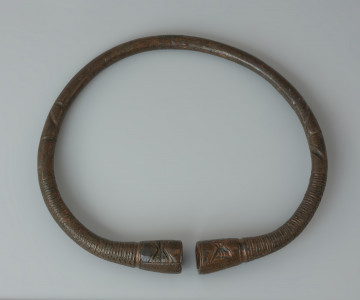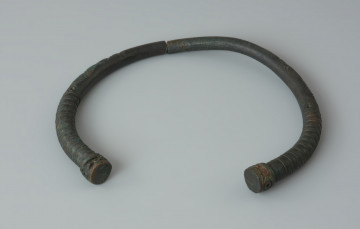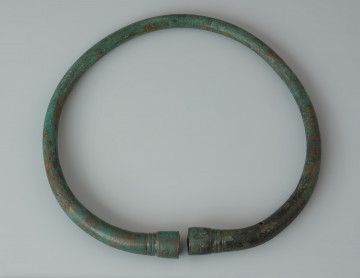
Necklace made of peccary and jaguar teeth
National Museum in Szczecin
Part of the collection: Antiquity
The iron belt hook is preserved only in fragments. Originally, it consisted of two segments, but only the larger one has survived, together with a connecting link, a kind of hinge, along with three fastening rivets. It is decorated with three parallel ribs, two running along the edge and the third one between them. Belt hooks were a part of the clothing in the last three centuries BC. The earliest specimens take the form of a simple bar or rod with the ends bent into hooks. Over time, more complex designs of hooks were developed. The bipartite specimens consist of two segments directly connected by loops wrapped around the end. Tripartite hooks have two arms connected by a separate link. The hinged hooks, as the name implies, consist of two flat arms connected by a shank - like a hinge. Belt buckles as we know them, consisting of a frame and a movable spike, appeared at the turn of the eras and displaced the less practical hooks from use. The presented specimen was found among the goods from a cremation urned grave in a cemetery in Kunowo, Stargard poviat. This necropolis was used by the people from Jastorf culture from the 3rd century BC until the turn of the eras. The body of the deceased was cremated and placed in a clay urn. The remains of the cremation pyre were used to cover the grave together with the urn. Such ritual was typical for the Jastrorf culture who always cremated their deceased. The inhumation burials were introduced in Western Pomerania in the 1st century, after the decline of Jastorf culture. The Kunów cemetery was discovered by accident in 1968 within a gravel pit. The rescue excavations were carried out by Ryszard Wołagiewicz from the Museum of Western Pomerania (currently the National Museum in Szczecin). In the area of 156 acres, he uncovered 71 archaeological sites, primarily cremation graves of the Jastorf culture and, in smaller numbers, of the earlier Lusatian culture.
Bartłomiej Rogalski
Author / creator
Dimensions
cały obiekt: height: 4.8 cm, width: 27.5 cm
Object type
furnishings and equipment; belt; belt buckle
Technique
metallurgical; forging
Material
iron
Creation / finding place
Owner
Muzeum Narodowe w Szczecinie
Identification number
Location / status

National Museum in Szczecin

National Museum in Szczecin

National Museum in Szczecin
DISCOVER this TOPIC
National Museum in Lublin
DISCOVER this PATH
Educational path